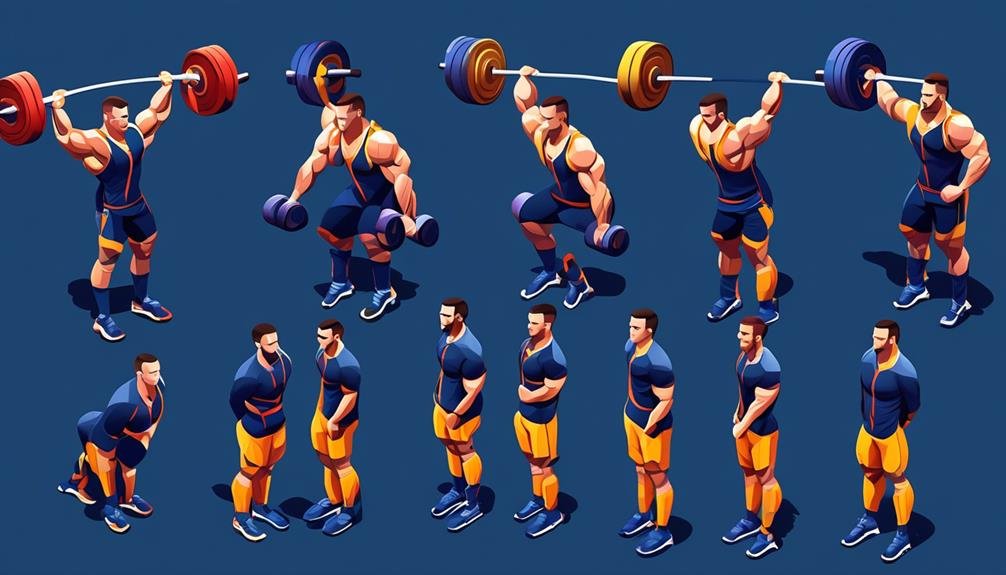Lifting weights overhead can be like navigating a treacherous path. One wrong move, and you could find yourself stumbling into the realm of injury. But fear not, dear reader, for there are ways to safely traverse this territory and emerge unscathed.
In this discussion, we shall explore the secrets to avoiding injury when lifting weights overhead, uncovering the importance of proper form, the significance of warm-up exercises, the common mistakes to steer clear of, and much more.
So, lace up your metaphorical boots and let's embark on this journey towards injury prevention, where strength and safety intertwine.
Key Takeaways
- Maintaining proper form and technique is essential to target the intended muscles and reduce the risk of strain or injury when lifting weights overhead.
- Incorporating warm-up exercises, such as arm circles, shoulder dislocations, cat-cow stretch, and scapular push-ups, helps prepare the body for overhead lifting and improves flexibility and stability.
- Common mistakes to avoid include failing to engage core muscles, arching the back, overextending the neck, using too much weight, not warming up properly, and lacking shoulder mobility.
- It is important to choose the right weight and equipment that challenge but allow for proper form, seek guidance from a fitness professional, listen to your body, take breaks when needed, and prioritize safety.
Importance of Proper Form
Proper form is crucial when lifting weights overhead to prevent injury and maximize effectiveness. By maintaining proper form, you can ensure that you're targeting the intended muscles while reducing the risk of strain or injury.
When lifting weights overhead, start by standing with your feet shoulder-width apart and your core engaged. As you lift the weight, keep your back straight and avoid arching or rounding your spine.
It's important to avoid jerking or swinging the weight, as this can put unnecessary stress on your joints and increase the risk of injury. Instead, engage your muscles and lift the weight in a controlled and steady manner.
Additionally, make sure to fully extend your arms overhead, without locking your elbows. This helps to maintain stability and prevent strain on your joints.
Remember to always start with lighter weights and gradually increase the load as your form improves. By prioritizing proper form, you can ensure a safe and effective overhead weightlifting routine.
Warm-Up Exercises for Overhead Lifting
To prepare your body for overhead lifting, it's crucial to incorporate warm-up exercises that activate the necessary muscles and increase flexibility, reducing the risk of injury. Here are four warm-up exercises you can include in your routine:
- Arm circles: Stand with your feet shoulder-width apart and extend your arms out to the sides. Begin making small circles with your arms, gradually increasing the size of the circles. This exercise helps warm up the shoulder joints and improve mobility.
- Shoulder dislocations: Hold a resistance band or a towel with both hands and extend your arms in front of you. Keeping your arms straight, lift the band or towel overhead and behind your back, then return to the starting position. This exercise helps increase shoulder flexibility and mobility.
- Cat-cow stretch: Get on all fours with your hands directly under your shoulders and your knees under your hips. As you inhale, arch your back and look up towards the ceiling (cow pose). As you exhale, round your spine and tuck your chin towards your chest (cat pose). This exercise helps warm up the spine and improve core stability.
- Scapular push-ups: Start in a high plank position with your hands directly under your shoulders. Keeping your arms straight, lower your chest towards the floor, allowing your shoulder blades to retract (squeeze together). Push back up to the starting position. This exercise helps activate the muscles in your upper back and improve scapular stability.
Remember to perform each exercise with control and focus on proper form. Incorporating these warm-up exercises into your routine will help prepare your body for overhead lifting and reduce the risk of injury.
Common Mistakes to Avoid

One common mistake when lifting weights overhead is failing to engage the core muscles for stability. Your core muscles, including your abdominals, obliques, and lower back, play a crucial role in maintaining proper form and preventing injury during overhead lifting exercises. When you neglect to activate your core, you put excessive strain on your lower back and increase the risk of injury. To avoid this mistake, make sure to engage your core muscles by drawing your belly button towards your spine and bracing your abs before lifting.
In addition to failing to engage the core, there are other common mistakes that you should be aware of when lifting weights overhead. To help you understand these mistakes better, here is a table highlighting five common errors and how to avoid them:
| Common Mistake | Why it's a Mistake | How to Avoid it |
|---|---|---|
| Arching your back | Puts excessive strain on the lower back | Maintain a neutral spine by engaging your core and keeping your back straight |
| Overextending your neck | Causes neck strain and potential injury | Keep your head aligned with your spine and avoid looking up or down |
| Using too much weight | Increases the risk of losing control and dropping the weight | Start with lighter weights and gradually increase as your strength and form improve |
| Not warming up properly | Increases the risk of muscle strains and injuries | Perform dynamic warm-up exercises to prepare your muscles and joints for overhead lifting |
| Lack of shoulder mobility | Limits your range of motion and increases the risk of injury | Incorporate shoulder mobility exercises into your warm-up routine and focus on proper form during lifting |
Choosing the Right Weight and Equipment
When selecting the appropriate weight and equipment for lifting overhead, it's essential to consider factors such as your current strength level, exercise goals, and comfort level. Here are four key considerations to help you choose the right weight and equipment:
- Start with a weight that challenges you but allows for proper form: It's important to choose a weight that's challenging enough to stimulate muscle growth, but not so heavy that it compromises your form. Gradually increase the weight as you become stronger and more comfortable with the movement.
- Use equipment that provides stability and safety: Opt for equipment that's sturdy, well-maintained, and designed specifically for overhead lifting. This includes barbells, dumbbells, or kettlebells with secure grips and proper weight distribution.
- Seek guidance from a fitness professional: If you're unsure about the appropriate weight or equipment to use for overhead lifting, consult with a qualified fitness professional. They can assess your current strength level, provide guidance on proper form, and recommend suitable equipment.
- Listen to your body: Pay attention to how your body feels during and after overhead lifting exercises. If you experience any pain or discomfort, adjust the weight or equipment accordingly. It's important to prioritize your safety and avoid pushing yourself beyond your limits.
Listening to Your Body and Taking Breaks

Are you aware of how your body feels during and after overhead lifting exercises? Listening to your body and taking breaks is crucial for avoiding injury when lifting weights overhead. Pay attention to any discomfort, pain, or fatigue that you may experience during your workout. If you feel any sharp or intense pain, stop immediately and seek medical attention if necessary. It's important to understand that pushing through pain can lead to serious injury.
Taking breaks is just as important as listening to your body. Allow yourself sufficient time to rest and recover between sets and workouts. Overtraining can put excessive strain on your muscles, joints, and connective tissues, increasing the risk of injury. Aim for at least 48 hours of rest between intense overhead lifting sessions.
In addition to rest, incorporating active recovery techniques can help prevent injury. Stretching, foam rolling, and performing mobility exercises can improve flexibility, reduce muscle soreness, and enhance overall performance. These practices also promote blood flow, which aids in the recovery process.
Incorporating Core Strengthening Exercises
To strengthen your core and reduce the risk of injury, incorporate a variety of exercises that target your abdominal muscles and improve overall stability. Here are four core-strengthening exercises that you can add to your routine:
- Plank: Start in a push-up position, with your hands directly under your shoulders and your body in a straight line. Engage your core muscles and hold this position for 30 seconds to a minute. As you get stronger, you can increase the duration.
- Russian Twist: Sit on the floor with your knees bent and feet flat on the ground. Lean back slightly while keeping your back straight. Hold a weight or medicine ball in front of you and twist your torso from side to side, touching the weight to the ground on each side.
- Bicycle Crunches: Lie on your back with your hands behind your head and your knees bent. Lift your head and shoulders off the ground, and bring your left elbow to your right knee while extending your left leg. Alternate sides in a cycling motion.
- Dead Bug: Lie on your back with your arms extended towards the ceiling and your knees bent at a 90-degree angle. Slowly lower your right arm and left leg towards the ground while keeping your core engaged. Return to the starting position and repeat on the opposite side.
Remember to start with proper form and gradually increase the intensity and duration of these exercises. Incorporating these core-strengthening exercises into your routine will help improve your stability and reduce the risk of injury when lifting weights overhead.
Seeking Professional Guidance and Coaching

If you're looking to take your core-strengthening routine to the next level and ensure proper form and technique, seeking professional guidance and coaching is highly recommended. A certified fitness professional or strength and conditioning coach can provide you with the necessary knowledge and expertise to perform overhead lifting exercises safely and effectively. They can assess your current fitness level, identify any muscle imbalances or weaknesses, and design a customized training program tailored to your specific needs and goals.
By working with a professional, you can learn the correct form and technique for overhead lifting exercises, such as the military press, push press, or snatch. They can teach you how to engage your core, stabilize your shoulders, and maintain proper alignment throughout the movement. This will not only reduce the risk of injury but also maximize the benefits of these exercises, including improved strength, power, and muscle definition.
To give you an idea of what to expect when seeking professional guidance and coaching, here is a table outlining the potential benefits:
| Benefits of Seeking Professional Guidance and Coaching |
|---|
| Individualized training program |
| Correct form and technique |
| Reduced risk of injury |
| Improved strength and power |
| Enhanced muscle definition |
Frequently Asked Questions
How Many Sets and Reps Should I Do When Lifting Weights Overhead?
You should start with a weight that challenges you but allows for proper form. Begin with 2-3 sets of 8-12 reps, gradually increasing weight and decreasing reps as you progress. Listen to your body and rest as needed.
Can I Lift Weights Overhead if I Have a Previous Shoulder Injury?
Yes, you can lift weights overhead with a previous shoulder injury, but it's crucial to consult a healthcare professional first. They can provide guidance on exercises and modifications to help prevent further injury.
Are There Any Specific Stretches I Should Do Before Lifting Weights Overhead?
Before lifting weights overhead, it's important to do specific stretches to avoid injury. Focus on stretching your shoulders, chest, and upper back to improve flexibility and warm up the muscles.
How Often Should I Incorporate Overhead Lifting Into My Workout Routine?
Incorporate overhead lifting into your workout routine 2-3 times a week. Start with lighter weights and gradually increase as you build strength and proper form. Listen to your body and rest if needed to prevent injury.
Is It Necessary to Use a Spotter When Lifting Weights Overhead?
It's important to use a spotter when lifting weights overhead to avoid injury. They can help you maintain proper form, provide assistance if needed, and ensure your safety throughout the exercise.
Conclusion
To avoid injury when lifting weights overhead, it's crucial to prioritize proper form, warm up properly, and avoid common mistakes.
Choose the right weight and equipment, listen to your body, and take breaks when needed.
Incorporating core strengthening exercises can also help prevent injury.
Seeking professional guidance and coaching can provide valuable knowledge and support.
By following these tips, you can safely and effectively lift weights overhead and reduce the risk of injury.







